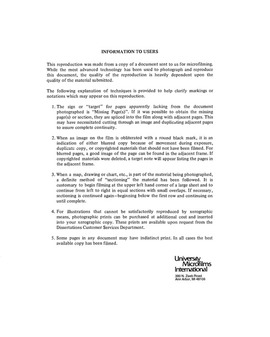| dc.contributor.author | Arbuckle, Nan, | en_US |
| dc.date.accessioned | 2013-08-16T12:29:16Z | |
| dc.date.available | 2013-08-16T12:29:16Z | |
| dc.date.issued | 1984 | en_US |
| dc.identifier.uri | https://hdl.handle.net/11244/5280 | |
| dc.description.abstract | These four categories may be discovered in each of these romances. Their presence indicates conscious efforts by these narrative poets to manipulate complex audience/text/narrator interaction. The sophistication of the use of the self-conscious narrator shows the medieval narrator in a direct line with his modern counterparts. | en_US |
| dc.description.abstract | The historian swears the story has authentic sources and may at times be used in a kind of auctour hide-and-seek. These intrusions are best examined by length and complexity. The didactic voice is not to be confused with the allegorical voice because its lessons are forthright, though its effects may often be opposite the stated intention. The narrator as guide relates the scenes and often distances the audience from the story by juxtaposing scenes with predictions of later action. That voice posing as the poet calls attention to the artistry of the work, at the same time encouraging the most audience involvement in the act of storytelling itself. | en_US |
| dc.description.abstract | Recent critical trends encourage a new examination of the techniques of narration, among them the self-conscious intrusive narrator. While critics have begun to analyze the effects of the repeated interruptions of such a narrator in the novel since the eighteenth century, few studies have dealt with the self-conscious narrator in medieval romance except to classify its presence as a sign of ineptitude. Nevertheless, examination of the intrusive narrators in Wolfram von Eschenbach's Parzival, Dante's Commedia, and Chaucer's Troilus and Criseyde shows self-conscious interruptions of the same manipulative type as more modern narratives. Intrusions break into four major categories: the historian, attesting the truth of the story; the didactic voice, illuminating the moral points; the guide, organizing the action; and the poet, discussing the creative act. Each of these four categories offers a variety of effects on the audience's interpretation of the section of narrative interrupted. | en_US |
| dc.format.extent | xiii, 263 leaves ; | en_US |
| dc.subject | Literature, Medieval. | en_US |
| dc.title | Categories of the self-conscious narrator in Wolfram, Dante, and Chaucer / | en_US |
| dc.type | Thesis | en_US |
| dc.thesis.degree | Ph.D. | en_US |
| dc.thesis.degreeDiscipline | Department of English | en_US |
| dc.note | Source: Dissertation Abstracts International, Volume: 45-08, Section: A, page: 2519. | en_US |
| ou.identifier | (UMI)AAI8425533 | en_US |
| ou.group | College of Arts and Sciences::Department of English | |
